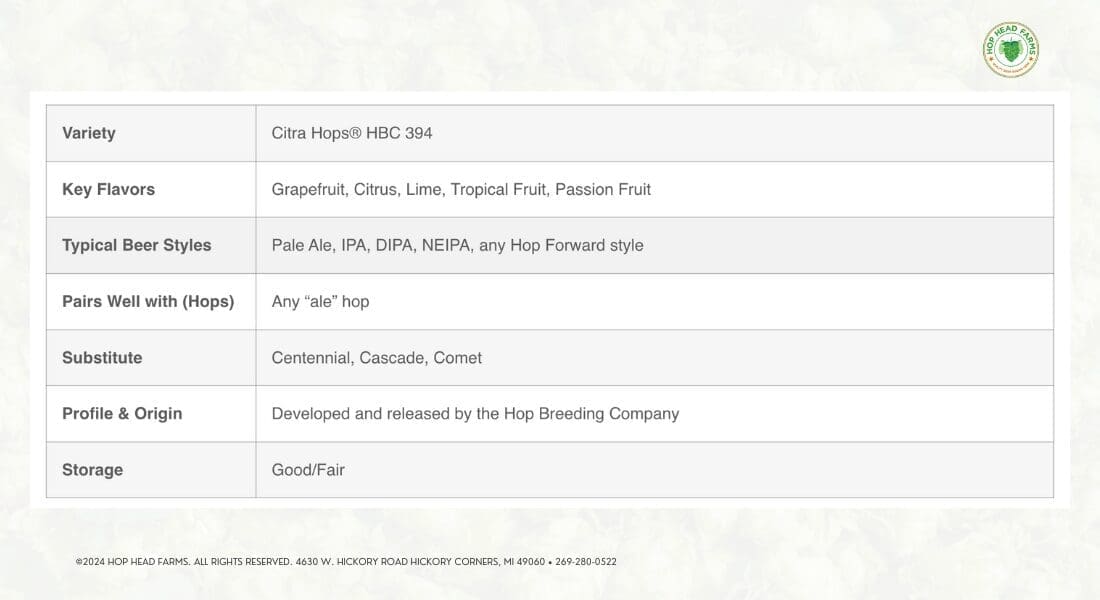Are you tired of bland beers that just taste “meh”? You’re not alone. Many homebrewers struggle to create the perfect hop-forward IPA with the bold, citrusy punch craft beer lovers crave. But what if you could brew a standout Citra IPA that’s bursting with flavor and aroma right in your own kitchen?
In this guide, we’ll show you exactly how to do it. From choosing the right ingredients to step-by-step dry hopping, you’ll have everything you need to craft a beer that rivals your favorite IPA. Let’s get started!
What Is a Citra IPA?
Citra IPA is a beer with citrusy, tropical vibes on your taste buds. The magic comes from the Citra hop, famous for its bold flavors of grapefruit, lime, and even hints of mango. Sometimes, it even has a quirky, “catty” edge that hop fans love.
At its core, a Citra IPA is a type of India Pale Ale (IPA), the rockstar of the craft beer world. IPAs are hops with a nice punch of bitterness and a balanced flavor.
Typically, they pack a moderate to strong ABV (5.5% to 7.5%). So, add Citra hops into the mix, and you get a beer that’s fresh, zippy, and unforgettable.

Why Choose Citra for Your Homebrew?
Citra hops are versatile and packed with flavor. Here’s why they’re a must-have for your homebrew:
- Flavor Explosion: Citra hops are loaded with juicy citrus and tropical fruit notes, adding a layer of complexity to your beer. Think mango, lime, and grapefruit in every sip.
- Brewing Flexibility: Citra hops work great at every step—whether you want to add bitterness, boost aroma, or finish with a flavorful dry hop.
- Instant Crowd-Pleaser: Craft beer fans love Citra, so using it in your IPA is a sure way to get good reviews.
What Equipment Do You Need to Brew a Citra IPA?
Before you start brewing, ensure you have the following equipment:
- Brew Kettle: A pot large enough for your boil volume (at least 5 gallons).
- Fermenter: A carboy or bucket with an airlock.
- Hydrometer or Refractometer: For checking OG and FG.
- Mesh Bag: For steeping grains or adding hops.
- Sanitizer: Essential for clean brewing equipment.
- Thermometer: To monitor mash and fermentation temp.
- Keg or Bottling Equipment: To package your beer.
Having the right brewing equipment sets the stage for a smooth brew day and great results.
How to Develop Your Citra IPA Recipe
A great Citra IPA starts with a well-thought-out recipe. Here are the key components:
- Malt Base: Use pale ale malt as your foundation. Add Munich malt for depth and Carapils for head retention.
- Hops: Citra is your star. Use it at every stage: bittering, aroma, and dry hopping.
- Yeast: Safale US-05 or White Labs 1056 are excellent ale yeast options.
- Water Chemistry: Adjust for a crisp, clean finish.
Experiment with additions of Citra to balance bitterness (measured in IBUs) and aroma.
What’s the Role of Dry Hopping in a Citra IPA?
Dry hopping is the process of adding hops after fermentation to boost aroma without increasing bitterness. Here’s how to make the most of it:
- Timing: Add 1-2 oz of Citra hops during the last 3-5 days of fermentation.
- Technique: Use a mesh bag to contain pellet hops and avoid clogging.
- Impact: Expect a vibrant, citrus-forward aroma that defines the Citra IPA experience.
Dry hopping with Citra is the key to elevating your IPA from good to great.
Step-by-Step Brew Day Process
Ready to make beer at home? Here’s a step-by-step guide:
- Mash: Combine 10 lbs of pale ale malt with 1 lb of Munich and mash at 152°F for 60 minutes.
- Sparge: Rinse grains with sparge water at 170°F to collect wort.
- Boil: Boil for 60 minutes, adding 1 oz of Citra hops at the start and 1 oz at flameout.
- Cool: Chill the wort to 68°F using a wort chiller.
- Fermentation: Transfer wort to a sanitized fermenter, pitch yeast, and ferment at 65°F.
This process ensures a balanced beer with a rich, hoppy flavor.
How to Monitor Fermentation for the Best Results
- Check OG and FG: Use a hydrometer to ensure your original gravity (1.041) and final gravity (1.012) are on target.
- Maintain Temp: Keep your fermenter at a consistent 65-68°F for optimal yeast activity.
- Sanitation: Prevent contamination by keeping everything sanitized.
Common Mistakes to Avoid When Brewing IPAs
- Over-Hopping: More isn’t always better. Balance is key.
- Poor Sanitation: Always sanitize your equipment to avoid off-flavors.
- Incorrect Yeast Handling: Pitch the right amount of yeast and control fermentation temp.
Tasting and Adjusting Your Citra IPA
- Flavor Check: Look for the signature citrus and tropical notes from Citra hops.
- Mouthfeel: Aim for a balanced carbonation and smooth finish.
- Adjustments: Note areas for improvement, like hop intensity or malt sweetness.
Citra IPA Recipe: A Step-by-Step Guide
- 10 lbs Pale Ale Malt
- 1 lb Munich Malt
- 1 lb Carapils
- 1 oz Citra (60 min)
- 1 oz Citra (Flameout)
- 2 oz Citra (Dry Hop)
- Safale US-05 Yeast
- Mash grains at 152°F for 60 minutes.
- Sparge with 170°F water to collect 6.5 gallons of wort.
- Boil for 60 minutes, adding hops as listed.
- Cool wort to 68°F and transfer to fermenter.
- Pitch yeast and ferment at 65°F.
- Dry hop with 2 oz of Citra during the last 5 days of fermentation.
- Keg or bottle, carbonate, and enjoy!
Premium Citra Hops at Hop Head Farms!
Key Takeaways
- Citra hops are a versatile, flavorful choice for brewing IPAs.
- Proper equipment and sanitation are essential for success.
- Develop a balanced recipe with the right mix of malt, hops, and yeast.
- Monitor fermentation carefully for best results.
- Use dry hopping to amplify aroma and flavor.
- Always taste and refine your recipe for future batches.


